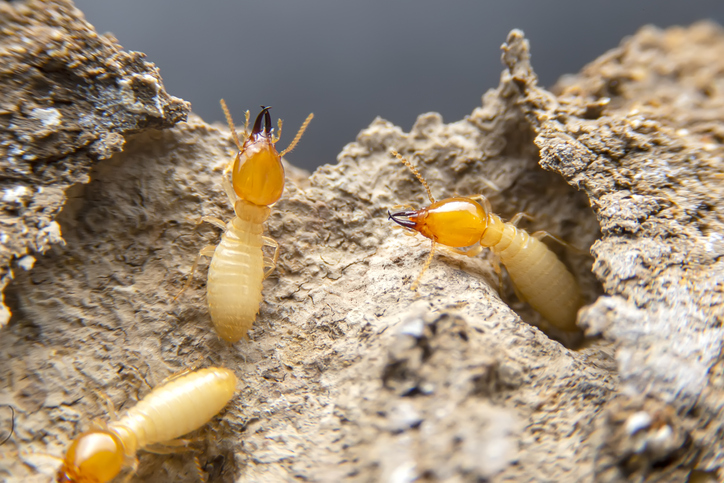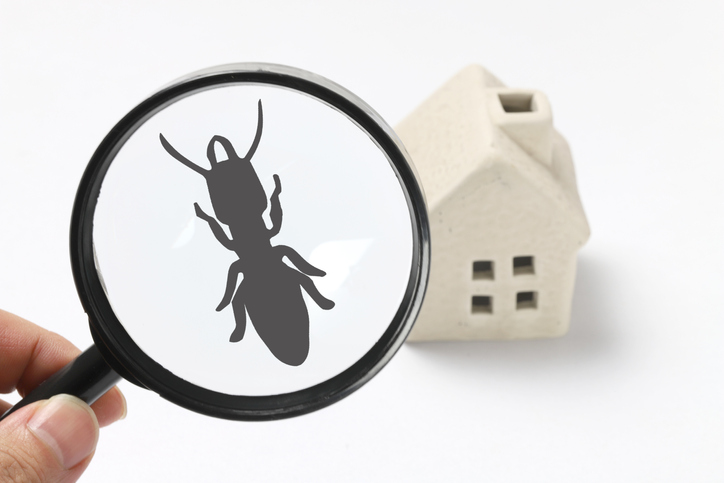Common house termites, specifically subterranean termites, typically have a similar appearance. They are small, measuring about 1/8 to 1/4 inch in length. Termites have soft bodies and are usually pale or light brown in color. They have straight antennae, straight-sided waists, and straight or slightly curved beaded antennae. Their bodies are divided into three segments: the head, thorax, and abdomen. While individual termites may seem inconspicuous, they live in large colonies comprising thousands or even millions of individuals working together to sustain the colony.

Are Termites Black?
Termites are not typically black in color. Most termites, including the common subterranean termites, are pale or light brown. However, it’s important to note that termite species can vary in appearance, and there are some termite species that may exhibit darker colors. For example, certain dry wood termite species may appear dark brown or black. It’s crucial to rely on a combination of physical characteristics and other signs of termite activity, such as mud tubes or damaged wood, to accurately identify a termite infestation rather than relying solely on color.
Do Termites Look Like Ants?
At first glance, termites can be mistaken for ants due to some similarities in appearance. However, there are distinct differences between the two. Termites have straight antennae, while ants have elbowed or bent antennae. Termites also have a broad waist that is not as constricted as that of ants. Additionally, the wings of termites are of equal size and shape, while ants have forewings that are larger than their hind wings.
What Do Termite Maggots Look Like?
Termite larvae, commonly referred to as termite maggots, have a different appearance compared to adult termites. Termite larvae are generally small, translucent, and worm-like in shape. They lack wings, have soft bodies, and are usually white or cream-colored. Termite larvae undergo several molting stages as they develop into adult termites within the colony. While it is uncommon to come across termite larvae outside of the nest, their presence may indicate an active termite infestation nearby. Identifying termite maggots typically requires professional expertise and inspection, as their presence is more commonly detected within the nest or during thorough examinations of termite activity.
Unique Attributes And Features Of Termites
Termites possess distinct characteristics and behaviors that set them apart from other pests. Understanding these unique attributes is essential for accurately identifying and dealing with termite infestations. From their winged reproductive members to the presence of a queen termite in the colony, termites exhibit fascinating features that contribute to their ability to establish and sustain their colonies.
Do Termites Have Wings?
Yes, some termites have wings, while others do not. Termites undergo a reproductive stage known as the swarming phase, during which winged termites, also called swarmers or alates, are produced. These swarmers are the reproductive members of the termite colony and are responsible for starting new colonies. They have two pairs of wings that are equal in size and shape. However, it’s important to note that not all termites within a colony develop wings. Only a select group of termites, typically the primary reproductives, have wings and are capable of flying.
Do Termites Make Noise?
Termites are generally not noisy insects, and they do not produce loud sounds or noises that are easily audible to humans. However, termites may create soft clicking or rustling sounds when they are in large numbers and are actively feeding or tunneling through wood. These sounds are produced by worker termites as they chew and excavate wood fibers. The sounds are usually faint and may require close proximity to the infested area to be heard. In most cases, the sounds produced by termites are not a reliable indicator of an infestation, and other signs such as damaged wood or mud tubes are more significant in identifying termite activity.
Is There A Queen Termite?
Yes, there is a queen termite in a termite colony. The queen termite is the largest member of the colony and plays a crucial role in reproduction. She is responsible for laying eggs and maintaining the growth and stability of the termite population. The queen termite can live for several years and is constantly attended to by worker termites who feed and care for her. Her primary function is to produce eggs, which hatch into termite larvae and eventually develop into different castes within the colony, such as workers, soldiers, and reproductive swarmers. The presence of a queen termite is vital for the survival and expansion of the termite colony.
A Deeper Dive Into Termite Species
Termites belong to the order Isoptera, and there are approximately 2,800 known species worldwide. While there are numerous termite species, the most common types encountered in structural infestations are subterranean termites, dry wood termites, and damp wood termites. Subterranean termites, such as the Eastern subterranean termite and the Formosan termite, are widely distributed and cause significant damage to wooden structures. Drywood termites, such as the Western dry wood termite and the Southeastern dry wood termite, infest dry wood and are commonly found in coastal areas. Dampwood termites, such as the Desert damp wood termite and the Pacific damp wood termite, are typically found in areas with high moisture levels and decayed wood.
What Do Outdoor Termites Look Like?
Outdoor termites, particularly the reproductive members known as swarmers or alates, exhibit distinct physical characteristics. These winged termites have two pairs of wings that are equal in size and shape, which can easily distinguish them from winged ants. The wings of outdoor termites are longer than their bodies and are often translucent or slightly opaque. The body coloration of outdoor termites can vary depending on the species, ranging from pale white or cream to dark brown or black.
Outdoor termites have straight antennae, a thick waist, and straight-sided bodies without any constrictions. Their overall appearance is similar to that of indoor termites, but their presence outdoors indicates their preference for nesting and foraging in natural environments such as trees, stumps, and soil.
Identifying Termite Presence
Termites can cause significant damage to structures if left untreated, making it essential to be vigilant in recognizing the signs of their presence. From physical characteristics like termite droppings and nests to other indicators such as damaged wood and mud tubes, understanding how to identify termite activity can help homeowners take appropriate measures to address infestations.
What Do Termite Droppings Look Like?
Termite droppings, also known as frass, are one of the signs that indicate the presence of termites. Termite droppings vary in appearance depending on the species of termite and the type of wood they are infesting. However, in general, termite droppings resemble small, elongated pellets or granules. They can be dark brown, black, or tan in color, resembling sawdust or coffee grounds. Termite droppings are typically found near infested areas, such as on windowsills, in spider webs, or around wooden structures. When inspecting for termite droppings, it is important to differentiate them from other types of debris or wood particles to accurately identify termite activity.
What Does A Termite Nest Look Like In The Ground?
Termite nests, also called mounds, are typically constructed by subterranean termites, which are the most common type of termites found in structural infestations. These nests are built in the ground and serve as the central hub for termite colonies. The appearance of termite nests can vary depending on the species and environmental conditions, but they generally exhibit certain characteristics. Termite mounds are often mound-shaped and can range in size from small to large, depending on the size and age of the colony. They are made up of a combination of soil, saliva, and termite excrement, giving them a distinctive texture and color.
Some termite nests may have external mud tubes or tunnels leading to above-ground food sources. Inside the nest, termite colonies consist of different chambers and galleries where various castes of termites live and carry out their specific roles. The presence of termite nests in the ground near a structure is a strong indication of a termite infestation and should be addressed promptly to prevent further damage.
The Battle Of The Flyers: Termites Vs. Ants
Termites and ants are both social insects that have winged reproductive members, often referred to as swarmers or alates. These flying individuals play a crucial role in the reproduction and expansion of their respective colonies. While flying termites and flying ants may appear similar at first glance, there are several key differences that can help distinguish between the two.
Body Shape
Flying termites have a straight-sided body with no constrictions, giving them a more cylindrical or tube-like shape. In contrast, flying ants have a distinct narrow waist or “pinched” appearance, separating their thorax from the abdomen.
Antennae
The antennae of flying termites are straight and bead-like, whereas flying ants have elbowed or bent antennae.
Wings
Termite swarmers have two pairs of wings that are equal in size and shape. These wings are typically longer than their bodies and are often translucent or slightly opaque. In comparison, flying ants have two pairs of wings as well, but the forewings are larger and longer than the hind wings.
Coloration
Flying termites usually have a pale or light color, ranging from white or cream to light brown. Flying ants, on the other hand, can vary in color, with species-specific variations including black, brown, red, or a combination thereof.
Behavior
Termites are known for their somewhat clumsy flight patterns, often flying erratically or in a straight line. They are attracted to sources of light and are typically seen swarming around windows, light fixtures, or other light sources. Flying ants, on the other hand, tend to have a more controlled and deliberate flight, and they are attracted to food sources or areas where they can establish new colonies.
Conclusion
Termites are small, social insects that can cause significant damage to structures if left unchecked. They have distinct physical characteristics that set them apart from other insects, such as their pale or light-colored bodies, straight-sided or cylindrical shape, and straight, bead-like antennae. Understanding what termites look like, including their winged reproductive members known as swarmers, can help homeowners identify potential infestations and take appropriate measures for termite control. Early detection and prompt action are key to minimizing the damage caused by termites and preserving the integrity of homes and structures. By staying vigilant and being knowledgeable about termite appearance, homeowners can protect their properties from the destructive impact of these silent invaders.




